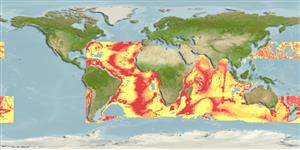>
Beryciformes (Sawbellies) >
Stephanoberycidae (Pricklefishes)
Etymology: Acanthochaenus: Greek, akantha = thorn + Greek, chaino = with the mouth opened (Ref. 45335).
Eponymy: Professor Christian Frederik Lütken (1827–1901) was a Danish naturalist, specialising in marine zoology. [...] (Ref. 128868), visit book page.
More on author: Gill.
Environment: milieu / Zona climática / intervalo de profundidade / distribution range
Ecologia
marinhas bentopelágico; intervalo de profundidade 1655 - 5397 m (Ref. 58018). Deep-water; 40°N - 57°S, 77°W - 164°W
Atlantic, Indian and Pacific: in subtropical and temperate waters (Ref. 50895). In the Indian Ocean known localities include the Madagascar Ridge (Ref. 51654) and the West Australian Ridge, Naturalist Plateau.
Comprimento de primeira maturação / Tamanho / Peso / Idade
Maturidade: Lm ?, range 12 - ? cm
Max length : 15.2 cm TL macho/indeterminado; (Ref. 41039)
Espinhos dorsais (total) : 0; Raios dorsais (total) : 11; Espinhos anais: 1; Raios anais : 9 - 10. Body scales are spiny (Ref. 37108). Body elongated, almost cylindrical, somewhat compressed (Ref. 10920). The snout protrudes forward above upper jaw, its length 3.4-4.4 times in head length, eyes fairly small, upper jaw extends beyond the posterior border of the eye. Dorsal and anal fins are opposite one another (Ref. 10920).
Body shape (shape guide): fusiform / normal.
Adults probably benthopelagic (Ref. 51654). Larvae taken at 30 m (Ref. 51654). Benthic crabs Malacostraca were found in the stomachs of 3 specimens SL 8.5-9 cm from Madagascar Ridge (Ref. 10920).
Ciclo de vida ou comportamento de acasalamento
Maturidade | Reprodução | Desova | Ovos | Fecundidade | Larvas
Maul, G.E., 1990. Stephanoberycidae. p. 611. In J.C. Quero, J.C. Hureau, C. Karrer, A. Post and L. Saldanha (eds.) Check-list of the fishes of the eastern tropical Atlantic (CLOFETA). JNICT, Lisbon; SEI, Paris; and UNESCO, Paris. Vol. 2. (Ref. 6535)
Status na Lista Vermelha da UICN (Ref. 130435: Version 2025-1)
Ameaça para os humanos
Harmless
Uso pelos humanos
Pescarias: sem interesse
Ferramentas
Relatórios especiais
Baixar XML
Fontes da internet
Estimates based on models
Preferred temperature (Ref.
123201): 1.4 - 3.2, mean 2 °C (based on 3882 cells).
Índice de diversidade filogenética (Ref.
82804): PD
50 = 1.0625 [Uniqueness, from 0.5 = low to 2.0 = high].
Bayesian length-weight: a=0.01122 (0.00514 - 0.02450), b=3.04 (2.87 - 3.21), in cm total length, based on all LWR estimates for this body shape (Ref.
93245).
Nível Trófico (Ref.
69278): 3.5 ±0.60 se; based on food items.
Generation time: 2.7 ( na - na) years. Estimated as median ln(3)/K based on 1
growth studies.
Resiliência (Ref.
120179): médio(a), tempo mínimo de duplicação da população 1,4 - 4,4 anos (Assuming tmax > 3; K=0.41).
Fishing Vulnerability (Ref.
59153): Low to moderate vulnerability (29 of 100).
🛈
